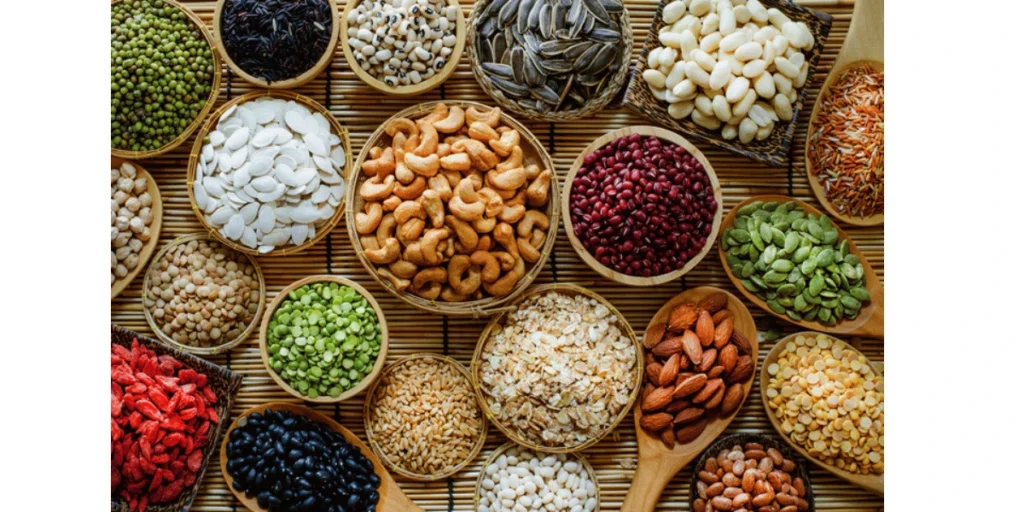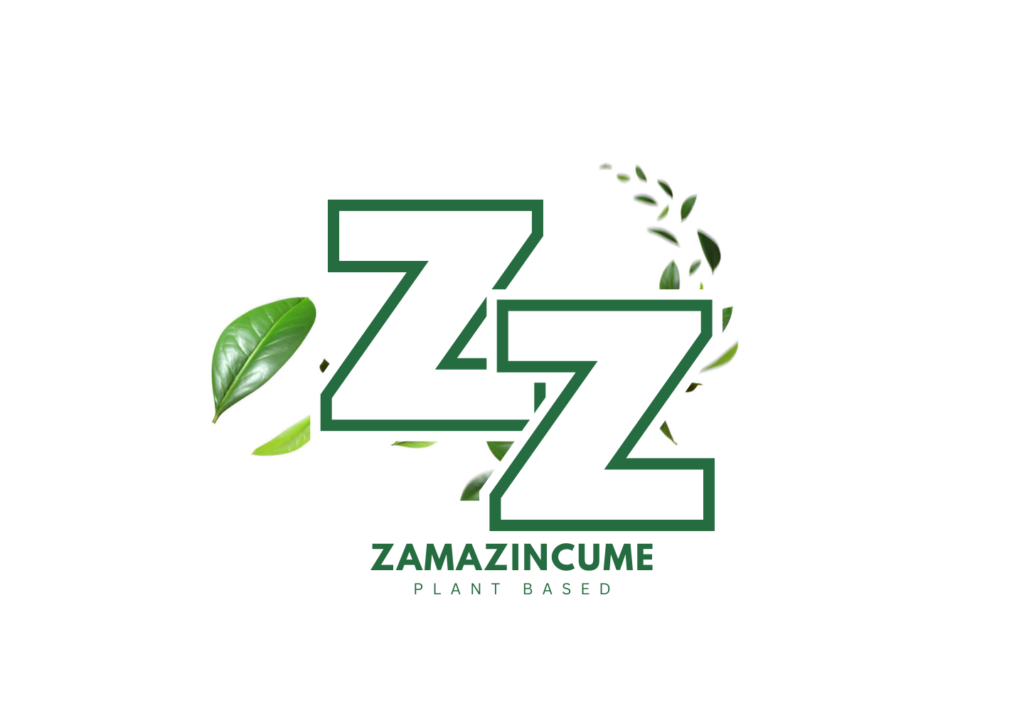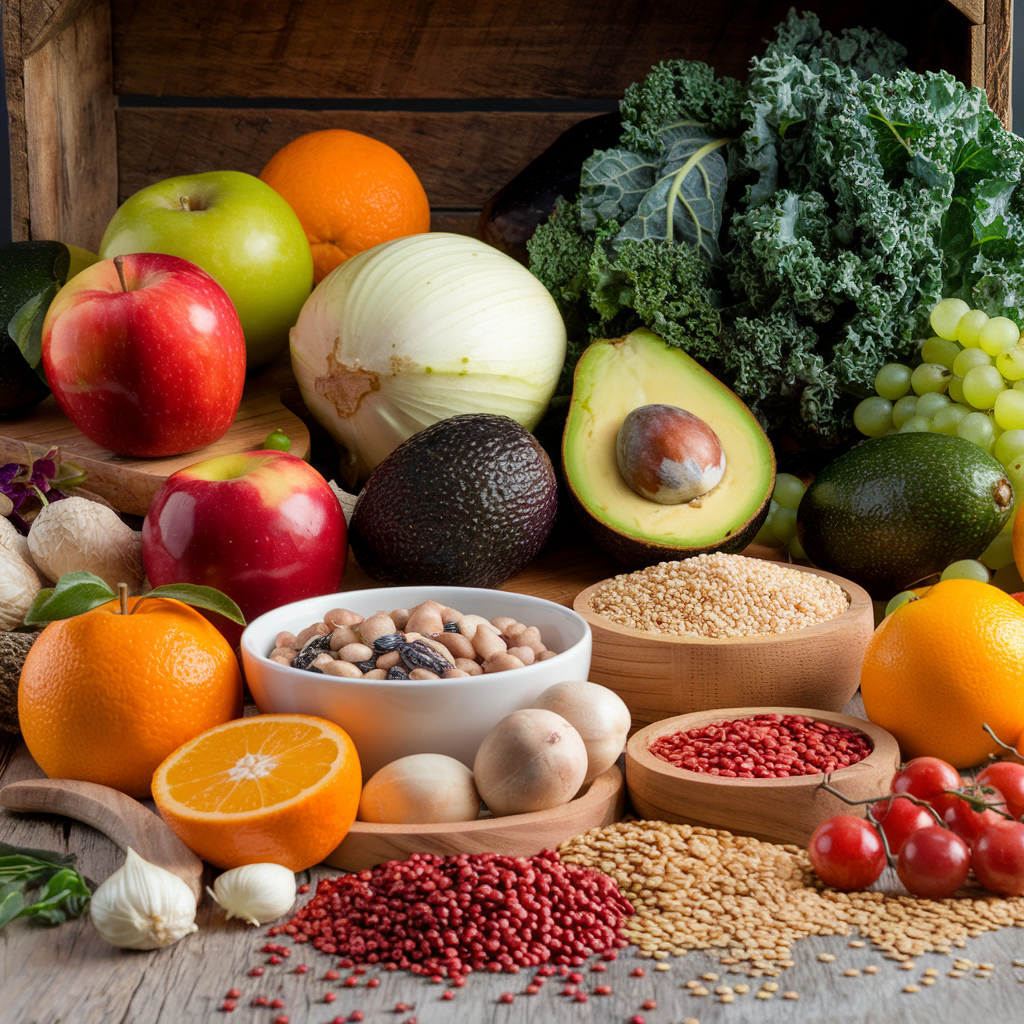Introduction
Here’s your comprehensive beginner’s guide to a plant-based diet.
Increasingly, more people are opting for a plant-based diet, and there are compelling reasons for this trend.
Many people are experiencing real improvements in their health by incorporating more plant-based foods into their diet.
Whether you want to improve your health, manage your weight, or find a better way to eat, you’re in the right place!
A plant-based diet emphasises the consumption of fruits, vegetables, whole grains, legumes, nuts, and seeds.
Adopting a plant-based diet does not require complete veganism; a diverse range of approaches exists.
Choosing this lifestyle can help you feel better and is also good for the planet.
In this beginner’s guide, I’ll help you start your plant-based journey with confidence.
Understanding the Plant-Based Diet Spectrum: More Than Just Vegan
I hope you’re looking forward to trying plant-based eating!
Defining a Plant-Based Diet
Let’s clear up what a plant-based diet means. There’s more variety than most people think.
When I began this journey, I realised it wasn’t only about being vegan, though that’s a strong approach.
The main foods on your plate will be fruits, vegetables, whole grains, legumes, nuts, and seeds.
These foods are packed with nutrients and make an excellent base for your meals.
This flexible approach is constructive if you’re just starting out.
Some who eat a plant-based diet may occasionally add small amounts of animal products. This could be a little dairy, eggs, fish, or even lean meats.
That’s why thinking of plant-based eating as a spectrum is so helpful, especially if you want to make changes gradually.
Types of Plant-Based Diets for Beginners
There are several popular types of plant-based diets, allowing you to choose one that feels right for you.
Think about being a flexitarian. This means you mostly eat plants, but still enjoy meat on occasion.
The vegetarian diet leaves out meat, poultry, and fish. It usually includes dairy and eggs. A pescatarian diet is similar but includes fish.
Of course, there’s also the vegan diet, which strictly avoids all animal products.
The Whole Food Plant-Based (WFPB) diet goes further. It emphasises unprocessed plant foods and reduces the use of refined ingredients.
I’ll explain each type so you can find the best place to start your plant-based journey.
The Abundant Benefits of a Plant-Based Diet for Beginners
A plant-based diet can really boost your health, so it’s worth thinking about.n.
One of the best reasons to try this eating style is the numerous health benefits it offers. It’s not just a trend—there’s real research behind it.
Health Benefits of a Plant-Based Diet
Switching to a plant-based diet can significantly reduce your risk of chronic diseases.
I’m referring to severe conditions such as heart disease, type 2 diabetes, and some cancers.
Eating whole, unprocessed plant foods can help lower your intake of saturated fat and cholesterol. This can improve your blood pressure and cholesterol levels.
In South Africa, chronic lifestyle diseases are a big worry. A healthy, plant-based diet can help prevent them. I’ve seen firsthand how dietary changes truly make a difference.
If managing weight is essential, a plant-based diet can be very effective. Fruits, vegetables, and whole grains are high in fibre. This helps you feel full longer. As a result, you may eat fewer calories.
Plus, your gut will feel better too!
I’ve seen that my digestion improves when I regularly eat a variety of plant foods.
This extra fibre and variety of plant compounds feed your gut microbiome. A healthy gut is essential for well-being.
When you focus on eating nutrient-rich foods, you might notice you have more energy and feel better overall.
Environmental Impact of a Plant-Based Diet
We should think about how the food we eat affects both our health and the environment.
A plant-based diet is also more environmentally friendly.
It’s a more sustainable way to eat. It has a lower carbon footprint, uses less water, and needs less land than diets rich in animal products.
Living in South Africa, I see firsthand the value of our natural resources. It motivates me to know my food choices can help the planet.
Ethical Considerations
For many people, like myself, caring about animal welfare is a significant reason to adopt a plant-based lifestyle.
It’s about matching my diet to my values. I see how our choices affect living beings.
As you can see, there are lots of benefits.
Essential Nutrients on a Plant-Based Diet: Fuelling Your Body
Great! You’re probably excited about all the benefits of a plant-based diet.
That’s awesome!
A frequent question is, “How do I obtain all essential nutrients on a plant-based diet?” I wondered this myself when I began.
I understand your concern. I’m here to assure you that it’s possible with some knowledge and effort.
Plant-Based Protein Powerhouses
Let’s start with plant-based protein, as this is often the first concern people have.
The plant kingdom contains an extensive selection of protein-rich foods. Legumes such as beans, lentils, and chickpeas are particularly beneficial.
Tofu, tempeh, and edamame are full of plant-based protein. They’re also very versatile for cooking.
Incorporate nuts and seeds, such as chia, flax, hemp, almonds, and walnuts, which provide healthy fats and protein.

Whole grains, such as quinoa, oats, and brown rice, provide a significant amount of protein in your daily diet.
It’s easier than you might think to get enough protein from plant foods.
Iron Absorption on a Plant-Based Diet
Next up, iron. This is another common concern, especially for women.
Plant-based iron (non-heme iron) isn’t absorbed as well as animal iron. However, many sources are available.
I make sure to include leafy greens, fortified cereals, and more of those excellent legumes in my diet.
Here’s a tip: eat iron-rich plant foods with something high in Vitamin C, like citrus, bell peppers, or berries. This helps your body absorb the iron much better—I’ve noticed it really works.
Calcium for Strong Bones on a Plant-Based Diet
Fortified plant milks, such as almond, soy, and oat milk, are excellent sources of calcium. They help keep bones strong. You can also get calcium from leafy greens, and if you enjoy it, calcium-set tofu is a brilliant source.
Vitamin B12: A Key Plant-Based Nutrient
Now, let’s talk about Vitamin B12. This one’s really important, and I always recommend paying attention to it if you eat a plant-based diet.
Vitamin B12 is primarily found in animal products. Choose plant-based foods, but remember to supplement with fortified options to ensure adequate nutrition. Nutritional yeast and some plant milks are good choices. I take a B12 supplement to be sure I’m covered. It’s a small step for a significant nutrient!
Omega-3 Fatty Acids in a Plant-Based Diet
Finally, let’s talk about Omega-3 fatty acids. While oily fish are well-known for their Omega-3s, we can also obtain them from plant sources. Flaxseeds, chia seeds, walnuts, and hemp seeds are excellent.
If you don’t consume these seeds regularly, consider taking an algal oil supplement. It’s a direct source.
Vitamin D on a Plant-Based diet
Remembering Vitamin D from sun exposure is key, especially in sunny South Africa. Also, choose fortified foods.
Paying attention to these nutrients helps me feel confident that my plant-based diet is providing my body with what it needs.
Transitioning to a Plant-Based Diet: Practical Steps for Beginners
Now that you know the benefits and key nutrients, you might be thinking, “I’m ready to try this!”
But how do I start making this shift to a plant-based diet?”
Trust me, I understand that feeling. When I first began my plant-based journey, it seemed a bit daunting. But I quickly learned that it doesn’t have to be an overnight overhaul.
Gradual Approach vs. Cold Turkey
One of the best tips I can give is to take it slow. I believe in this approach instead of going cold turkey.
For many, a sudden switch can feel restrictive and unsustainable. Instead, why not try “Meatless Mondays” to begin? Or perhaps commit to just one plant-based meal a day?
You can slowly add more plant-based foods to your meals. This makes it easier for your taste buds, digestion, and habits to adjust. Soon, you’ll find yourself choosing more tasty plant-based options without even thinking about it.
Stocking Your Plant-Based Pantry
To succeed, I recommend stocking your plant-based pantry. When I did this, it made cooking so much easier.
Fill it with staples like whole grains. Try oats for breakfast. Use quinoa and brown rice as versatile side dishes. Whole-wheat pasta makes quick meals easy. Load up on legumes; canned beans and lentils are incredibly convenient, while dried ones are very budget-friendly. Don’t forget a good variety of nuts and seeds for healthy snacks and meal additions.
Frozen fruits and vegetables are great for smoothies and quick meal prep. They offer convenience and make cooking easier.
Keep your favourite plant-based milks and yoghurts ready. Also, don’t forget herbs and spices. They add great flavour to your new dishes!
Meal Planning for a Plant-Based Diet
Meal planning makes a big difference. To build balanced plant-based meals, include protein sources, healthy fats, and complex carbs.
A typical dinner for me is lentil curry with brown rice and steamed greens on the side. For lunch, I often make a big batch of chickpea salad to use in sandwiches or wraps throughout the week.
Spending an hour or two on Sunday for batch cooking can be extremely helpful. It saves time and cuts down stress during busy weekdays.
And don’t worry about missing out!
Smart Swaps for a Plant-Based Diet
There are numerous outstanding plant-based swaps available today—you might be surprised by how easy they are.
For instance, I often use lentils or mushrooms as a substitute for mince in dishes like shepherd’s pie.
Tofu can be scrambled just like eggs. There are also lots of dairy alternatives, like almond milk, oat milk, soy milk, and cashew cream, so you won’t feel like you’re missing out.

Eating Out on a Plant-Based Diet
Eating out on a plant-based diet can seem challenging at first. But with practice, it gets easier.
I’ve learned to navigate restaurant menus confidently. I then look for vegetarian or vegan sections, or ask for modifications.
Most restaurants are happy to help if you let them know what you need.
Remember, this is your plant-based journey, and every small step counts!
Delicious Plant-Based Recipes for Beginners: Simple & Satisfying
Now that you know how to stock your pantry and plan meals, let’s talk about the fun part: the food!
When I first started on my plant-based diet, I was worried it would be bland or complicated.
There are lots of tasty plant-based recipes for beginners. They’re simple, satisfying, and you don’t need to be a chef to enjoy them.
Plant-Based Breakfast Ideas
Let’s start with some plant-based breakfast ideas.
For me, a warm bowl of oatmeal topped with fresh berries, a sprinkle of nuts, and a drizzle of maple syrup is a go-to. It’s quick, comforting, and keeps me full for hours.
If you want something savoury, a tofu scramble is easy to make. Additionally, it’s rich in protein. Crumble firm tofu and sauté it with your favourite veggies, like spinach and mushrooms. Add a bit of turmeric for colour.
A quick smoothie is ideal for busy South African mornings. Blend plant-based milk, a banana, spinach, and a scoop of protein powder.
Enjoy!
Quick Plant-Based Lunch Options
For quick plant-based lunch options, I often turn to hearty soups or simple sandwiches.
A big pot of lentil soup with carrots, celery, and a rich tomato base is very nourishing. It lasts for days.
One of my favourites is a “chickpea salad” sandwich. Just mash chickpeas with vegan mayo, celery, and herbs. Then, pile it onto whole-wheat bread.
If you want to try something fun, make a colorful grain bowl with roasted veggies, black beans, and a tasty tahini dressing. It looks great and fills you up.
Fulfilling Plant-Based Diners
And when it comes to plant-based dinners, there are so many options. One of my favorites is a veggie stir-fry. Fill it with colourful bell peppers, broccoli, and snap peas. Then, I add cubed tempeh for texture and protein. Everything gets tossed in a tasty soy-ginger sauce.
Black bean burgers are a great choice. You can buy them ready-made or make your own from scratch.
A classic whole-wheat pasta with a rich roasted vegetable sauce is a hit in my home. It includes tomatoes, zucchini, and eggplant.
Plant-Based Snack Ideas
Don’t forget about plant-based snack ideas either!
Fresh fruits, crunchy veggies with hummus, and a handful of nuts or seeds are great snacks. Roasted chickpeas with paprika also help curb hunger between meals.
Plant-based cooking can open up a whole new world of flavours and fun in your kitchen.
Common Challenges and Solutions for Plant-Based Beginners
I’ve been there. I know that starting a plant-based diet can be tough at times. It’s not always easy or perfect every day!
Plant-based beginners face some common challenges. The good news? I’ve found practical solutions.
Firstly, you may initially feel hungry on a plant-based diet.
My solution?
Make sure to include fibre, plant-based protein, and healthy fats in every meal. Lentils, nuts, and avocados become your best friends!
Then there are social situations and a plant-based diet. This can feel awkward, I understand. I try to share my choices clearly and kindly. I often offer to bring a tasty plant-based dish to share. It showcases how tasty this lifestyle can be!
Ultimately, overcoming cravings on a plant-based diet is a genuine challenge.
Instead of feeling deprived, I focus on finding healthy, satisfying plant-based substitutes. For me, a date-and-nut energy ball often hits the spot when I’m craving something sweet.
Remember, every small step you take is progress on your plant-based journey. You can do this!
Plant-Based Diet Frequently Asked Questions (FAQ)
As you embark on your plant-based diet journey, it’s natural to have questions. I certainly did when I first started!
Here are some common questions I’ve heard, along with the insights I’ve learned.
What’s the difference between a plant-based diet and being vegan?
This is a popular one!
A plant-based diet emphasises consuming more foods derived from plants and fewer foods from animals. It can also be flexible. Veganism is a stricter lifestyle. It excludes all animal products and by-products. This means no animal food, clothing, or other items in your life. So, while all vegans are plant-based, not all plant-based eaters are vegan.
Is a plant-based diet healthy?
Absolutely! Based on my experience and research, a well-planned plant-based diet can provide all the essential nutrients you need. It also offers many health benefits, including improved heart health and enhanced digestion.
How do I get enough protein on a plant-based diet?
How do I get enough protein on a plant-based diet?
This was a big one for me initially! I’ve found it easy to get protein from various sources. These include legumes like beans and lentils, tofu, tempeh, nuts, seeds, and whole grains. Protein is everywhere in the plant kingdom, once you know where to look.
Do I need to take supplements on a plant-based diet?
Vitamin B12 is mostly found in animal products. So, it’s usually a good idea to take supplements. You may need additional supplements based on your specific needs and dietary requirements. However, B12 is the one I focus on the most.
Is a plant-based diet expensive?
Not at all! Focusing on whole, unprocessed plant foods can save money. Dried beans, lentils, rice, and seasonal vegetables are often affordable in South Africa. This diet is budget-friendly compared to one that relies heavily on meat and dairy.
Can you lose weight on a plant-based diet?
Yes, definitely. A balanced plant-based diet is high in fibre and low in calories. This can help you lose weight if that’s your goal. It certainly helped me feel lighter and more energetic.
Conclusion
I hope this guide has inspired you and provided you with everything you need to begin your plant-based journey.
We’ve discussed the great benefits of a plant-based diet.
We covered how to get essential nutrients and easy steps for a smooth transition. The plant-based choice you make helps both you and the planet stay healthy.
Are you ready to give this way of eating a try? I believe you can do it! You can do it!



One Response